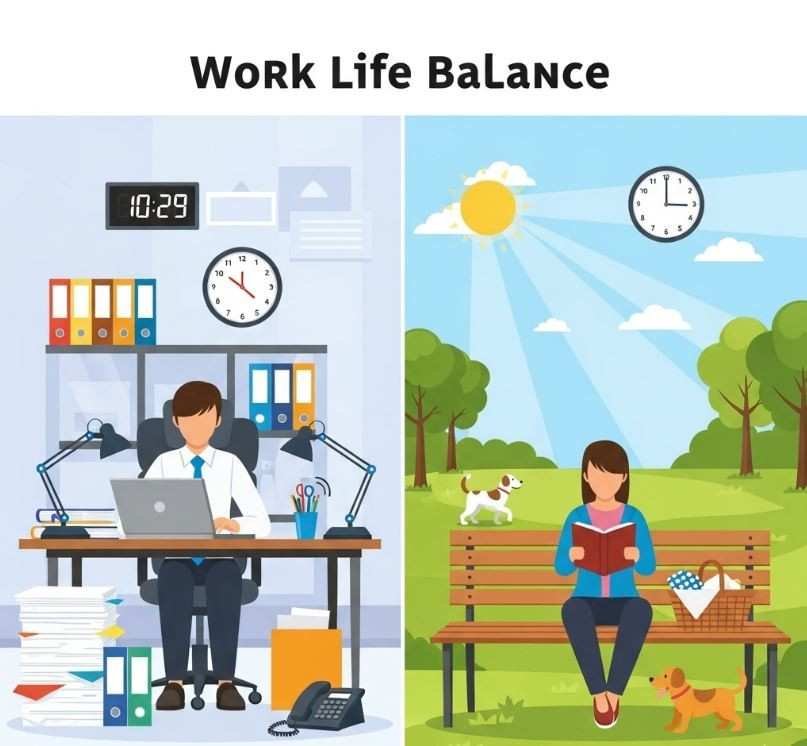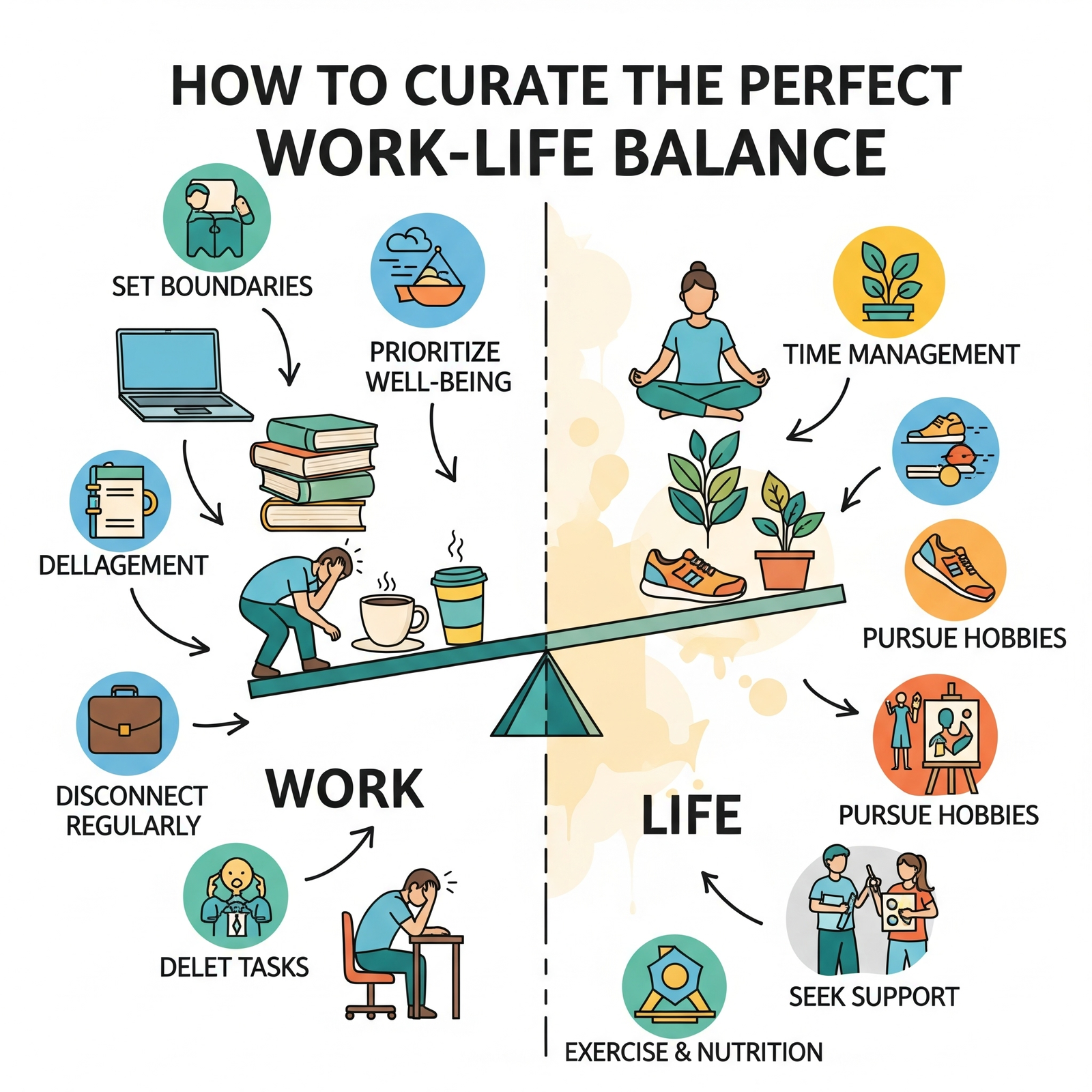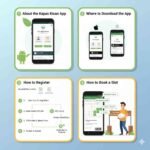
How to Curate the Perfect Work-Life Balance in 2025
Finding balance between professional responsibilities and personal well-being has become more complex than ever. Remote work, digital connectivity, and evolving workplace expectations have blurred traditional boundaries, making it challenging to switch off and truly disconnect from work demands.
The good news? Creating a sustainable work-life balance isn’t about perfect time management or rigid scheduling. It’s about understanding your unique needs, setting intentional boundaries, and making strategic choices that support both your career growth and personal fulfillment.
This comprehensive guide explores practical strategies for achieving work-life balance that actually works for your lifestyle. You’ll discover how to identify your personal balance priorities, create boundaries that stick, and build systems that help you thrive in both professional and personal areas of your life.
Understanding Your Personal Balance Equation
Work-life balance looks different for everyone. What energizes one person might drain another, and what feels balanced during one life stage may feel completely off during another.
Identify Your Core Values
Start by clarifying what matters most to you across different life domains. Consider these key areas:
Professional fulfillment: What aspects of work give you the greatest sense of purpose and achievement? Is it creative problem-solving, mentoring others, or building something from scratch?
Relationships: Which relationships require your time and attention to flourish? This might include family, friends, romantic partners, or community connections.
Health and wellness: What does optimal physical and mental health look like for you? Consider sleep, exercise, nutrition, stress management, and mental health support.
Personal growth: How do you prefer to learn and develop? This could involve formal education, creative pursuits, spiritual practices, or skill-building activities.
Career and professional goals: What aspirations do you have for your work life? Reflect on your current career path, the skills you aim to develop, and the milestones you hope to achieve. Consider how your professional endeavors align with your personal values and long-term vision.
Financial stability: What does financial well-being mean for you? This might involve setting clear budgeting goals, establishing an emergency fund, planning for retirement, or reducing debt. Identifying your financial priorities can help you create a more secure and stress-free future.
Recreation and hobbies: How do you recharge and find joy? Incorporating recreation and hobbies into your life allows you to explore your passions, enhance creativity, and maintain a balanced lifestyle. From traveling to learning a new instrument, consider how these activities contribute to your happiness and fulfillment.
Community and contribution: How do you give back and connect with the world around you? Engage with causes you care about, whether through volunteering, advocacy, or other forms of contribution. Building a sense of community and purpose can create a positive impact on both your life and the lives of others.
Assess Your Current Reality
Take an honest look at how you’re currently spending your time and energy. Track your activities for one week, noting:
- Hours spent on work-related tasks (including email, calls, and thinking about work)
- Time dedicated to relationships and social connections
- Hours devoted to health and self-care activities
- Energy levels throughout different parts of your day
- Moments when you feel most and least fulfilled
Identify Your Priorities
Once you’ve tracked your activities, reflect on what truly matters most to you. What areas of your life bring you the greatest joy, fulfillment, or sense of purpose? Consider your personal values, long-term goals, and the relationships that mean the most to you. Make a list of your top priorities and compare them to how you’re currently spending your time. This exercise can highlight any misalignments and guide you toward more intentional choices.
Eliminate Time Wasters
With a clear understanding of your priorities, it’s time to identify and eliminate activities that don’t align with your values or goals. These might include excessive screen time, unproductive meetings, or tasks that can be delegated or postponed. Instead, redirect this time and energy toward the things that matter most to you. By consciously cutting out distractions, you can create more space for meaningful pursuits and enhance your overall well-being.
This assessment helps identify gaps between your stated values and actual time allocation. You might discover you’re spending far more mental energy on work than you realized, or that you’ve been neglecting relationships that matter deeply to you.
Setting Boundaries That Actually Work
Effective boundaries aren’t walls that completely separate work and life. They’re more like flexible filters that help you manage when, where, and how different aspects of your life intersect.
Digital Boundaries
Technology can be your greatest ally or your biggest obstacle to work-life balance. Create intentional rules around digital connectivity:
Communication windows: Establish specific times when you’re available for work communications. For example, you might check email three times per day rather than constantly monitoring your inbox.
Device-free zones: Designate certain areas of your home or specific times of day as technology-free. Many people find that keeping phones out of bedrooms significantly improves sleep quality and relationship connections.
App management: Use built-in screen time controls or third-party apps to limit access to work-related applications during personal time. Consider separate work and personal devices if your budget allows.
Physical Boundaries
Even if you work from home, creating physical separation between work and personal spaces helps your brain transition between different modes.
Workspace setup: If possible, designate a specific area for work that you can “close” at the end of the day. This might mean shutting a door, covering your computer, or simply turning your chair away from your desk.
Commute rituals: Create a symbolic transition between work and personal time. This could be a short walk around the block, changing clothes, or listening to a specific playlist that helps you mentally shift gears.
Communication Boundaries
Clear communication about your availability and limits helps manage others’ expectations while protecting your personal time.
Availability communication: Let colleagues, clients, and even family members know when you’re available and when you’re not. Be specific about response times for different types of communications.
Boundary explanations: When you need to maintain a boundary, offer brief explanations rather than lengthy justifications. For example: “I’m not available for work calls after 7 PM, but I can discuss this first thing tomorrow morning.”
Energy Management Over Time Management
Traditional time management focuses on fitting more activities into your schedule. Energy management recognizes that your capacity fluctuates throughout the day and prioritizes activities when you have the right kind of energy for them.
Identify Your Energy Patterns
Pay attention to your natural rhythms over several weeks:
Peak performance times: When do you feel most mentally sharp and capable of complex work? Many people experience peak cognitive performance in the morning, but individual patterns vary significantly.
Creative windows: When do new ideas come most easily? Some people are morning creatives, while others find their imagination flows better in the evening.
Social energy: When do you feel most capable of meaningful interactions with others? This includes both professional relationships and personal connections.
Recovery needs: What activities help you recharge, and when do you most need them? This might be physical exercise, quiet reflection, creative pursuits, or social connection.
Understanding your rhythms: Identifying your natural rhythms can be transformational in managing both your energy and productivity. For instance, aligning your most demanding tasks with your peak performance hours can lead to more effective work and greater satisfaction. Similarly, scheduling restorative activities during periods of low energy can help prevent burnout and improve overall well-being. By tuning into when you’re at your best—whether creatively, socially, or physically—you can craft a daily schedule that maximizes your potential and promotes balance.
Align Activities with Energy
Once you understand your patterns, structure your days to match high-energy times with demanding activities and low-energy periods with easier or restorative tasks.
Work scheduling: Tackle your most challenging work projects during your peak performance hours. Save routine tasks like email or administrative work for times when your energy is lower.
Personal priorities: Schedule important personal activities during times when you have appropriate energy for them. If you’re drained after work, intense exercise might not be sustainable, but a gentle walk could be perfect.
Flexibility planning: Build buffer time around high-energy activities so you’re not rushing from one demanding task to another. This helps maintain your energy reserves throughout the day.
Energy renewal: Incorporate regular breaks and practices that help replenish your energy. This might include mindfulness exercises, stretching, or even a short nap if possible. These intentional pauses can enhance focus and prevent burnout, ensuring that you’re able to sustain productivity over longer periods.
Listen to your body: Everyone’s energy levels fluctuate uniquely, so it’s crucial to remain attuned to your body’s signals. If you feel your energy waning, it’s a sign to pause and refocus instead of pushing through and risking diminished outcomes. By aligning your activities with your natural rhythms, you promote both efficiency and well-being.
Long-term habits: Cultivate routines that support sustainable energy, such as prioritizing quality sleep, staying hydrated, and maintaining a balanced diet. Consistency in these areas provides a strong foundation for productivity and allows you to approach daily challenges with resilience.
Creating Sustainable Daily Routines
Sustainable routines support your goals without requiring constant willpower or decision-making. The key is starting small and building gradually.
Morning Routines That Set You Up for Success
Your morning routine doesn’t need to be elaborate or time-consuming to be effective. Focus on activities that help you feel grounded and prepared for the day ahead.
Consistent wake times: Try to wake up at roughly the same time each day, even on weekends. This helps regulate your circadian rhythm and improves sleep quality over time.
Mindful transitions: Build in a few minutes of intentional awareness before diving into your day. This might be deep breathing, writing in a journal, or simply drinking your coffee without distractions.
Priority setting: Spend a few minutes reviewing your day’s priorities and intentions. This helps you make more intentional choices throughout the day rather than simply reacting to whatever comes up.
End-of-Day Rituals
How you end your workday significantly impacts your ability to be present during personal time and sleep well.
Work closure: Create a specific ritual that signals the end of your work time. This might involve writing down tomorrow’s priorities, tidying your workspace, or reviewing what you accomplished.
Transition activities: Choose activities that help you mentally and emotionally shift from work mode to personal mode. This could be physical exercise, a hobby, or spending time with loved ones.
Evening wind-down: Develop a consistent pre-sleep routine that helps your body and mind prepare for rest. This might include dimming lights, avoiding screens, or practicing relaxation techniques.
Managing Work Demands Without Burnout
Achieving work-life balance doesn’t mean being less effective at work. Instead, it’s about working more strategically and sustainably.
Strategic Priority Setting
Not all work tasks are equally important, even when they all seem urgent. Develop systems for identifying what truly deserves your time and energy.
Impact assessment: Before taking on new projects or commitments, consider their potential impact on your key goals. High-impact activities deserve priority, while low-impact tasks might be delegated, delayed, or eliminated.
Energy cost evaluation: Some tasks require more mental or emotional energy than others. Factor this into your planning so you’re not scheduling multiple high-energy tasks back-to-back.
Saying no strategically: Develop comfortable ways to decline requests that don’t align with your priorities. This might involve suggesting alternatives, referring people to other resources, or simply explaining that you’re not available.
Delegation and Collaboration
You don’t have to handle everything yourself. Effective delegation and collaboration can improve outcomes while reducing your individual workload.
Skill matching: Identify tasks that others might be able to handle more efficiently or effectively than you can. This isn’t just about saving time—it’s about leveraging everyone’s strengths.
Development opportunities: Look for ways to delegate that also provide learning opportunities for colleagues or team members. This creates value for others while reducing your long-term workload.
Clear communication: When delegating or collaborating, provide clear context about goals, expectations, and timelines. This prevents miscommunication and reduces the need for multiple follow-ups.
Nurturing Relationships and Personal Interests
Strong relationships and personal interests aren’t just nice-to-haves—they’re essential for long-term well-being and even professional success.
Relationship Maintenance
Meaningful relationships require intentional investment, but they don’t all need the same type or amount of attention.
Quality over quantity: Focus on deepening a smaller number of meaningful relationships rather than trying to maintain superficial connections with everyone you know.
Presence over perfection: When you’re spending time with important people, practice being fully present rather than multitasking or mentally planning other activities.
Regular check-ins: Schedule regular contact with important people in your life. This might be weekly phone calls with family, monthly dinners with friends, or daily brief conversations with your partner.
Personal Interest Development
Engaging in activities you enjoy isn’t selfish—it’s essential for maintaining your identity and well-being outside of work.
Skill-building hobbies: Choose activities that challenge you and provide opportunities for growth. This might be learning a new language, developing artistic skills, or mastering a sport.
Restorative activities: Include activities that help you recharge without requiring significant effort or skill development. This could be reading, gardening, or listening to music.
Social interests: Consider activities that combine personal enjoyment with social connection, such as joining clubs, taking classes, or participating in community organizations.
Technology Tools That Support Balance
The right technology can help automate routine tasks and create better boundaries between work and personal life.
Automation and Efficiency Tools
Calendar management: Use calendar applications to block time for both work priorities and personal activities. Treat personal commitments with the same respect you give to professional meetings.
Task management: Digital task managers can help you capture and organize both work and personal responsibilities so nothing important falls through the cracks.
Communication scheduling: Many email and messaging platforms allow you to schedule messages to be sent during business hours, even if you write them at other times. This helps maintain professional boundaries while accommodating your preferred work style.
Boundary-Supporting Apps
Focus applications: Apps that block distracting websites or applications during designated work times can help you be more productive during work hours, making it easier to disconnect afterward.
Meditation and mindfulness: Guided meditation apps can help you develop stress management skills and create peaceful transitions between different parts of your day.
Sleep tracking: Understanding your sleep patterns can help you make better decisions about evening activities and morning routines.
Building Your Support Network
Creating sustainable work-life balance is easier when you have support from others who understand your goals and challenges.
Professional Support
Mentors and advisors: Connect with people who have successfully navigated similar career challenges and can offer guidance on managing professional demands.
Peer networks: Build relationships with colleagues or professionals in your field who share similar values around work-life balance. These relationships can provide mutual support and accountability.
Professional development: Invest in skills that help you work more efficiently and effectively. This might include time management training, communication skills, or technical skills that automate routine tasks.
Personal Support
Family understanding: Have honest conversations with family members about your work demands and personal priorities. Help them understand how they can support your balance goals.
Friend accountability: Share your work-life balance goals with trusted friends who can help you stay accountable to your priorities and remind you to take breaks when needed.
Professional services: Consider hiring help for routine personal tasks if your budget allows. This might include house cleaning, grocery delivery, or other services that free up time for higher-priority activities.
Adapting Your Approach Over Time
Work-life balance isn’t a destination you reach and then maintain forever. Your needs, circumstances, and priorities will change, and your approach to balance should evolve accordingly.
Regular Assessment and Adjustment
Quarterly reviews: Every few months, assess how well your current approach is working. What’s going well? What feels unsustainable? What changes in your life or work require adjustments to your balance strategy?
Life transition planning: Major life changes—such as new jobs, relationships, moves, or family changes—require intentional adjustments to your work-life balance approach. Plan for these transitions rather than simply hoping things will work out.
Seasonal adjustments: Your balance needs might vary with seasons, both literally and metaphorically. You might need different approaches during busy work periods, family obligations, or changes in your personal energy and motivation.
Continuous Learning and Experimentation
Try new approaches: Don’t be afraid to experiment with different strategies for managing your time, energy, and priorities. What works for others might not work for you, and what works for you now might not work forever.
Learn from setbacks: When your balance feels off, treat it as information rather than failure. What circumstances contributed to the imbalance? What early warning signs did you notice? How can you respond differently next time?
Celebrate progress: Acknowledge improvements in your work-life balance, even if you haven’t achieved perfect equilibrium. Progress often happens gradually, and recognizing positive changes helps maintain motivation for continued growth.
Stay flexible: Life is dynamic, and so is the concept of balance. What works for you today might need to be adjusted tomorrow due to changing priorities, new opportunities, or unexpected challenges. Stay open to reassessing your approach regularly, and don’t be afraid to pivot when necessary. Flexibility ensures that your strategies for balance remain relevant and effective.
Set boundaries: One of the most crucial aspects of maintaining work-life balance is learning to say no. Clearly define your limits, both professionally and personally, to prevent over-commitment. Whether it’s setting specific work hours, limiting screen time, or protecting personal evenings, boundaries allow you to focus on what truly matters without feeling stretched too thin.
Seek support: You don’t have to achieve balance alone. Reach out to mentors, colleagues, family, or friends when you need advice or encouragement. Sometimes an outside perspective can shed light on solutions you hadn’t considered. Additionally, consider professional resources, like counselors or coaches, if you need structured guidance on managing stress and enhancing your overall well-being.
Finding work-life balance is an ongoing process, but with intentionality, self-reflection, and a willingness to adapt, you can create a fulfilling and sustainable rhythm for all aspects of your life.
Making Work-Life Balance Your Reality
Creating sustainable work-life balance requires patience, experimentation, and commitment to your own well-being. Start with small changes that feel manageable rather than trying to overhaul your entire life at once.
Remember that balance doesn’t mean equal time allocation—it means intentional choices that support your values and goals. Some weeks will be work-heavy, others will prioritize personal needs, and that’s perfectly normal.
The key is developing the self-awareness to recognize when adjustments are needed and the skills to make those adjustments effectively. With consistent attention and thoughtful planning, you can create a sustainable approach to work-life balance that evolves with your changing needs and circumstances.
Your future self will thank you for the investment you make today in creating a more balanced, fulfilling life. Start with one small change, build momentum gradually, and trust the process of creating a life that works for you.
Read more articles here
- How to Download Your Telangana Family Member Certificate Soft Copy (FMC)
- Top 5 Indian Cities to Buy Property in 2025: Investment & Growth Guide
- 100+ Unique Anniversary Wishes for Everyone You Know
- Top 15 Best Indian Social Media & AI Apps (2025): Revolutionizing Bharat’s Digital Future
- 1000+ Happy Birthday Wishes for Everyone in Your Life










